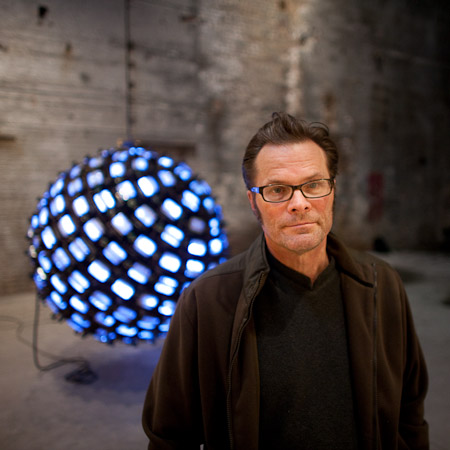
photo by Eric Ryan Anderson
Joe Amrhein stands in the glare of a floodlight and surveys the rising clutter that crowds this giant brick cavern, a towering old boiler room that he must transform, in two short weeks, into an extension of Pierogi 2000, his small but influential art gallery a few blocks away. “It’s starting to fill up in here,” he says with a satisfied smile. “We’re already running low on space.” Earlier, Amrhein ushered in two sizable arrivals: the six-foot wooden crate that holds an 800-pound sphere made of security monitors, and an even-larger metal crate containing a four-and-a-half ton piece of Antarctic ice.
Just a week earlier, this defunct boiler room in a factory on Williamsburg’s North 14th Street looked like the backdrop for the dramatic confrontation of a film noir. The room’s dirty brick walls stretch nearly fifty feet to the ceiling, where a metal catwalk spans the room’s width. Birds swing in and out, perching on the broken panes of a window, where a dim light ekes through decades of grime. A brick boiler, built in 1931, stands like an industrial mausoleum with hinged, steel portholes and a melange of pipes turning at right angles, winding across each other and doubling back, as if Jules Verne had contributed the first sculpture to this new expedition.
Amrhein calls the space, simply, the Boiler, and he’s betting (quite literally) that it can revive a Williamsburg art scene that has flashed and faded in the fifteen years since he established Pierogi in 1994. In the mid-90s, Pierogi’s “Flat Files – an archive of flat, affordable works housed in pull-out cabinets – introduced collectors and curators to a new generation of North Brooklyn artists, and soon, Art in America was declaring Pierogi the “premier Williamsburg gallery…with a robust international reputation.” But the Williamsburg art scene has cooled in the past few years, as the art world has increasingly returned to Chelsea, and, with the opening of the New Museum, back to the Lower East Side. Amrhein thinks the Boiler can transcend the worldwide slump in the art market, and revive the Williamsburg scene.“The Boiler will be a new draw and a new energy, to get collectors and critics out here to filter out through Williamsburg again.”
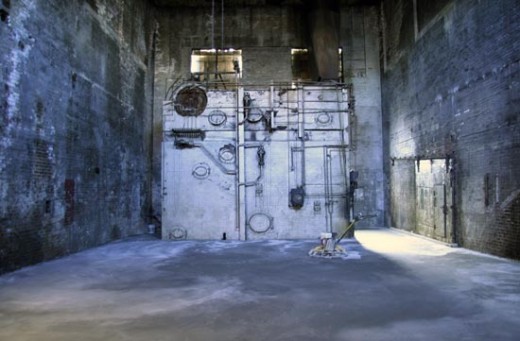
In stained cargo pants and a black thermal coat, Amrhein looks more like a construction foreman than a celebrated gallerist, as he issues soft-spoken orders to a half-dozen employees and volunteers. The room’s clutter serves as a constant reminder of work to be done before the gallery opens on March 7. Sheets of plywood lean against the gray brick walls, long wooden crates lay horizontally on the new concrete floor, and aluminum panels rest against the huge boiler. At its base, a half-dozen industrial batteries are stacked like over-grown Legos, and a folding table holds a collection of drills and hammers. Scattered raindrops thump the buckets beneath a few predictable leaks. Amrhein has just unhinged the iceberg’s shell, poured 200 pounds of dry ice into the crate, and now he sets to unscrewing the long wooden containers that hold the slab’s solar refrigerator.
The icy hulk makes for a fitting first piece.It has already survived brief shows in Miami and the artist’s native Bahamas, but this month-long exhibition will be its longest and most ambitious run to date. Amrhein has weathered vicissitudes in the hot-and-cold art market, but opening a new, large-scale space in the midst of a frigid economy – and an art market that is practically frozen – feels like the same kind of survivalist, man-against-nature experiment.
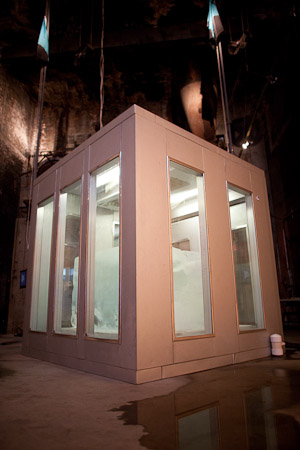
“It seems like there’s always a recession when you’re trying to get over a hump,” Amrhein says. His desire for new space grew, in part, from the closing of a similarly large gallery he had opened in Leipzig, Germany two years ago. Rising gas prices and other inflated costs forced Amrhein to downsize that gallery in the fall, and to look for a similar space closer to home. “When we started in September, we didn’t know the market was going to crash so much,” Amrhein admits.But he confronts the challenge with a characteristic shrug, saying, “we’ve always had that do-it-yourself mentality.”
Amrhein is an artist too, and like almost any artist, his life has been a constant battle between his art and his bottom line. Amrhein grew up in Sacramento, the youngest of four children, and he credits his father with instilling a dutiful work ethic. “My dad was very creative, but he was a mailman,” Amrhein says. “He was really interested in working somehow in the arts, but he was always more concerned with having a secure job.” Amrhein fell in love with painting as a high school student, and says he had two teachers who saw his talent and encouraged it. “They always said I should have gone for scholarships, but I never did,” Amrhein says.
Instead, Amrhein moved to Lake Tahoe after high school, where he made metal jewelry using wax casts – a process called “lost wax” — and saved his earnings. After a year, he moved back to Sacramento, where Amrhein and his brother opened Century Sign Painting, a design and painting firm that specialized in business graphics. The business was profitable, and Sacramento had a number of interesting artists, but in 1980, Amrhein re-located to San Francisco. In his spare time, Amrhein attended lectures at the San Francisco Art Institute.
San Francisco also had a small community of artists, but Los Angeles was the capital of the West Coast art world, and in 1981, Amrhein moved south. By 1983, his work was appearing in group shows at museums like the Los Angeles Museum of Art, and in 1985, he had asolo show at the Fiona Whitney Gallery in Hollywood. The show consisted of oil-on-Masonite paintings, depicting everyday scenes from several fragmented angles, and it received a short, but positive, review in the Los Angeles Times. The Times said Amrhein combined “elements of Cubist fragmentation, the sculptural, hard-edge purism of Ellsworth Kelly, and painterly, Expressionist realism, in a provocative format this is clearly more than the simple sum of its parts.”
There were more group shows, and a smattering of solo shows – including one back in San Francisco and another in Zurich – but by 1989, New York’s fabled art scene drew him east. “I was an artist, and my destiny lay here in New York,” Amrhein says with a laugh. He expected to find an apartment in Manhattan, but the rent was too high, so he settled in Williamsburg.
In New York, Amrhein did what he had always done: he worked on his own art while he earned a living painting signs. But here, the two began to converge. Conceptual, text-based art was coming into vogue, and artists needed experienced painters to install their pieces on gallery walls. Lothar Baumgarten, a German artist with a studio in New York, hired Amrhein to help install a solo exhibition at the Guggenheim. Amrhein painted the names of Indian tribes along the museum’s iconic spiraling rotunda in large, two-foot letters. The exhibition was a success.Art in America said Baumgarten had “made words more than reading material. The medium transcended its message.”
Baumgarten hired Amrhein to help install his pieces all over the world, and suddenly, Amrhein was making good money and working with the luminaries of the art world — just not in the way he had intended. “It was kind of ironic because my artwork was still sitting in my studio and languishing,” he recalls, “while I was meeting all these great people through my sign-painting business.”
In 1994, a local gallerist suggested that Amrhein host a group show at his studio on North 9th Street. He did, and the show was a hit. He organized another one, and soon named the fledgling space Pierogi 2000, a nod to the Polish community in the area. “When we started, I just wanted to develop a dialogue and get the energy going and participate more. It was all about participation.” He invited anyone in the area to contribute to a new project called the Flat Files – a glorified filing cabinet where artists could store their work for others to browse, and with any luck, buy. Pierogi did not formally represent the artists, but provided a space where artists could send curators and collectors to see their work, which gave even struggling artists a welcome air of legitimacy.
“When Joe had an opening, everybody came because they all had their art there. It was like rooting for the home team,” says artist Ward Shelley, who had a piece in the show that launched Pierogi, and whose painting Williamsburg Timeline has made him an unofficial historian of the local arts community. “So the scene really grew up around Pierogi.”
Pierogi became a destination. “It was the first time we weren’t the bridge and tunnel people anymore,” Amrhein says. “There was this sort of activity happening outside of Manhattan that became undeniable. A lot of curators and critics and gallerists would come out looking for artists and things were happening here because of that location and accessibility to space.”
Shelley remembers warehouse parties that were part rave, part art exhibit, and Amrhein sees the Boiler is a throwback to that era. “It’s like Old Williamsburg, the space, back when Williamsburg was much more of a loose cannon. It has that sort of possibility.”
He wants to recreate a slice of those days by opening the space for poetry readings, film exhibitions. and whatever else an artist might devise.(He has tentative plans to host 100 carpenters simultaneously nailing on boards, at the request of an artist who composes aural works.)
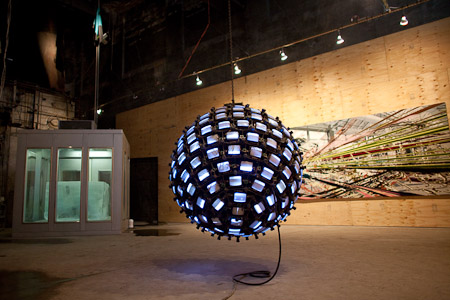 But the Boiler is also a nod to the current reality, in which Amrhein is a gallerist representing more than two dozen artists, many of whom make large-scale sculptures. Williamsburg artist Jonathan Schipper created the security camera sphere that is part of the upcoming opening, and his solo show will be the Boiler’s second exhibition. Schipper says the sphere was never shown at Pierogi; it couldn’t fit through the doors. “I’ve always been proud to show at Pierogi, but as an artist who does bigger stuff, I’m really excited,” Schipper says. “It definitely keeps me happy staying in Brooklyn, as opposed to going to Chelsea and looking at places, and thinking ‘Wow!’”
But the Boiler is also a nod to the current reality, in which Amrhein is a gallerist representing more than two dozen artists, many of whom make large-scale sculptures. Williamsburg artist Jonathan Schipper created the security camera sphere that is part of the upcoming opening, and his solo show will be the Boiler’s second exhibition. Schipper says the sphere was never shown at Pierogi; it couldn’t fit through the doors. “I’ve always been proud to show at Pierogi, but as an artist who does bigger stuff, I’m really excited,” Schipper says. “It definitely keeps me happy staying in Brooklyn, as opposed to going to Chelsea and looking at places, and thinking ‘Wow!’”
Schipper says Amrhein’s experience as an artist makes him a unique gallery owner.“You don’t get the pep and enthusiasm, the ‘We’re going to take over the world and sell everything!’ He’s more sincere and thoughtful. He can actually sit down and talk about the work,” Schipper says. Tavares Strachan, the artist who made the ice sculpture, says Amrhein worked with him to develop the piece. Amrhein sacrificed the commissions on Strachan’s smaller works to pour the money back into the ice project, which to date, has cost nearly $100,000. “I feel like there’s a certain kind of audacity that Pierogi has,” says Strachan. “One of the things that’s unique about artists is that they don’t really get that something can’t happen, and I think that’s part of his philosophy,” Strachan says. “You don’t see barriers, you see solutions.”
“I definitely think it will inspire people,” says Ward Shelley. “Knowing the space is there starts to affect what you dream about.People are drooling at doing something that size.” That Amhrein is opening the Boiler at this time, in this economy, only makes the space more inspiring, more do-it-yourself, and more quintessentially Williamsburg. “It’s something that’s not about caution and fear,” says Shelley. “It’s not the kind of thing the Guggenheim would do, it’s the kind of thing an artist would do.”
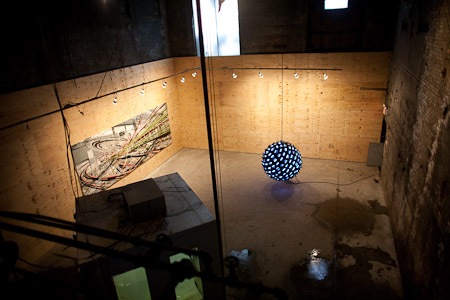
Amrhein continues to show his own art, and he has a solo show opening the same week that the Boiler opens, but he insists on keeping his own work distinct from his gallery, lest Pierogi become “a vanity thing.” “As good or as bad as my art might be, it has to be decided upon in another venue.” Some one else has to consider it good enough to show. So you sort of have to separate the two, and it can be frustrating at times. Because I want to show my own work, and talk about my work.”
For the next two weeks his only canvas will be the concrete floors and grimy brick of the Boiler. “I think running the gallery is an art project, an art piece. The decisions you make are very similar to any decisions you would make in your work. How to develop the work, how you can encourage new thought and new ideas, where you’re going next.”
Editor’s Note: The Boiler opened March 7, with a packed house spilling out onto North 14th Street.
Leave a Reply